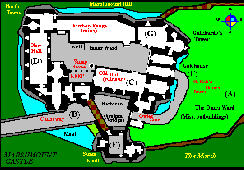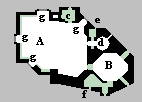 |
||
 Gwernogle Castle |
 Braise of Lepidopter |
 Marshmount Castle |
| Guichardo's |  |
Folly |

Castle aficionados all have their own favorites, but there is often ambiguity about that --
some offering more in the way of picturesqueness, others in historical interest, still others in fortification techniques. Well, why not design your own ideal castle project
that combines all of the aspects that you would find of interest if such a place existed?
Here are five (well, really four and a half) of my own such efforts, which I have indulged
in for over thirty years -- these are the only ones I've put on the Internet so far. Click on
any of the images to go to its own web page.
My challenge to you, if this appeals to you, is to submit your own "imaginary" castle
to this site. If there is enough interest, I'll even set up a web ring for it, and maybe even
in some cases host your web pages of your imaginary castle for free if you'll let me move it to Tripod, into my own castle site (keeping your own creditation of course).
You have to be a compulsive sort of person to do this sort of thing, but it is a lot of fun,
rather like making balsa model airplanes from scratch, or making a quilt or tapestry.
In a way, if you do it right, it combines the mental skills of architecture and historical
fiction research.
There are no rules to this project, apart from the fact that I am the sole judge of what
is fit!
Let's just try one on the fly:
Poltruvanel Castle (Cornwall) An ancient hill fort of the Celts in pre-Roman days that was reconstituted in the so-called dark ages around the time of King Arthur. It was supposedly the site of the Virgin Castle of the Galahad legends, where he had a bit of trouble maintaining his holiness while searching for the Holy Grail and trying to keep his virtue. Ralph of St. Malo was given this castle by William the Conqueror in 1083 and built a motte-and-bailey on the site. It never became an important fortress in a military sense, although it was the center of a large manorial estate and was noted for its fine ashlar walls and kitchen accommodations in the Tudor period. Oliver Cromwell's troops sacked and burned it, and it never recovered from that, most of its stone having been stolen over the centuries since then to repair barns, etc. There is nothing left to see now except the earthwork embankments and the lines of the old curtains walls, at most chest-high, which now enclose farmyards. (One side of the farmhouse includes a truncated portion of the gatehouse tower, and the remains of the Celtic rath are used as a sheep pound. What is left of the kitchen range is now a popular pub, called "The Wholly Virgin," which is noted for its shepherd's pies and hard cider, brewed locally in the old castle stables.) Want to see a ground plan? And click here for the pub.
Get the idea?
If you would like to enter this contest, which expires on the 31st of December 2000, please send your submission to GrobiusShortling. I said there were no rules, but I meant you should preferably submit a web page, not just e-mail text or a word document. Of course, if the latter is any good I will go to the trouble of converting it to HTML, but for the most part don't send me off-the-cuff e-mail with lots of misspellings, etc. Please.... You can also apply using the convenient e-mail form below.
"Virtual Castles" are acceptable, by the way, and I have entered some without permission (though I will e-mail the authors).
Here are the contestants so far
|